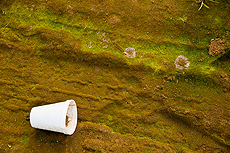So long, Styrofoam
 |
Styrofoam does not biodegrade. Fermilab is taking steps to reduce Styrofoam use at the laboratory. Photo: hermitsmoores |
Picture Main Ring Road lined with Styrofoam cups. Now think of Styrofoam cups circling Main Ring Road 17 times. That is 68 miles of Styrofoam cups! And it is how many cups have been used by Fermilab since 2010 — 1,188,000 of them. It may surprise you to learn that that total does not include cups from the cafeteria. This many cups were ordered through the Stockroom by employees.
As a small step in greening Fermilab, the laboratory's Sustainability Committee and FESS' Logistics and Property Control Group have decided to eliminate Styrofoam (correctly known as polystyrene foam) cups available in the stockroom. They will be replaced by paper cups that contain 10 percent post-consumer recycled content from recycled office paper. The paper cups cost three times as much as their polystyrene equivalent, but the price is only about four cents more per cup: Polystyrene cups are about two cents each, while each paper cup is about six cents.
While the per-paper-cup cost is low, we recognize that it is nevertheless an increase in price. Our hope is that this change will encourage people to think twice about using disposable, single-use cups in the first place. Even New York City has banned single-use polystyrene foam as of July 1.
Polystyrene is made of benzene and styrene, toxic substances that are suspected carcinogens and neurotoxins. It does not biodegrade: The cup will dissolve in about 500 years, but the chemicals will remain in the ecosystem. In the United States, about 25 billion cups are thrown away each year, and that's only the polystyrene found in cups, not other packaging or food containers. Polystyrene consumes more than 25 percent of landfill space. It is not recyclable by municipalities.
Unfortunately, we cannot control or eliminate all uses of polystyrene at Fermilab. But Fermilab's Logistics and Property Control collects clean number 6 white packaging foam at Wilson Hall, Feynman Computing Center and the Cross Gallery for recycling at the Dart facility in Aurora. They will also do special pickups if you have a large quantity to dispose of. Packaging peanuts are also collected at Warehouse 2 to be reused by the Shipping Department.
We all should do our part to decrease our use of disposable, single-use items such as Styrofoam coffee cups. Be Earth-friendly and bring your own mug from home to be used not only in your office but also at meetings or events. If you purchase coffee with your own mug at the cafeteria, you will even receive a discount! And while you're at it, check out the stockroom's other greener options, which carry an "SA" in the Stockroom number. You can also search for "environmentally friendly" in the description.
Sometimes the greener choice costs more in the short term, but in the long term, the benefits to society outweigh the short-term price.
—Katie Kosirog
|